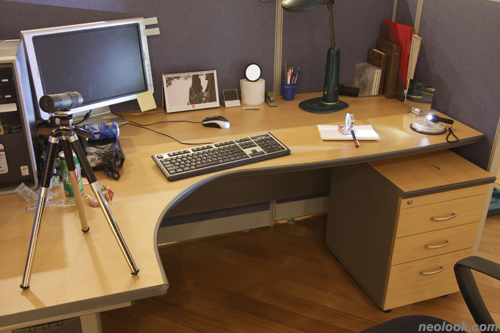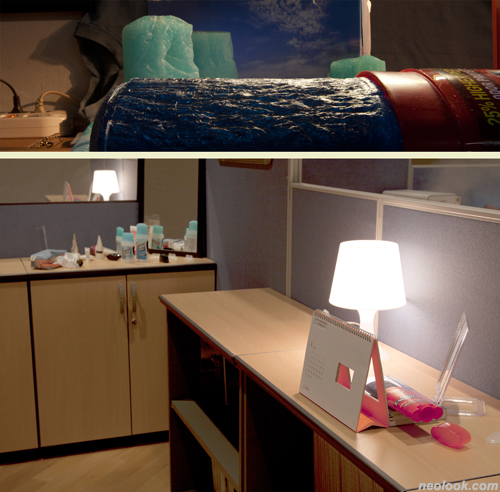- ● homepage
- ● archives
- ● restoration
- ● books
- ● big banners
- ● post board
- ■ neo's search
- ■ about us
- ■ 게재방법 안내
- 개인정보처리방침

- [email protected]
- Tel. 02_335_7922
- Fax. 02_335_7929
- 10:00am~04:30pm
- 월요일~금요일
- 3/3(월) 대체공휴일

대안풍경 Alternative Landscape
강호연展 / KANGHOYEON / 姜鎬然 / installation 2013_0425 ▶ 2013_0530 / 일,공휴일 휴관

- 강호연_아이스란드 Iceland_망원경, 삼각대, 거울, 이면지, 가습기, 손걸레 등_가변설치_2011 강호연_아이스란드 Iceland_C 프린트_59.4×40.77cm_2013
초대일시 / 2013_0425_목요일_06:00pm
송은 아트큐브는 젊고 유능한 작가들의 전시활동을 지원하기 위해 (재)송은문화재단에서 설립한 비영리 전시공간입니다.
관람시간 / 09:00am~06:30pm / 토요일_01:00pm~06:00pm / 일,공휴일 휴관
송은 아트큐브 SongEun ArtCube 서울 강남구 대치동 947-7번지 삼탄빌딩 1층 Tel. +82.2.3448.0100 www.songeunartspace.org
교차하는 풍경 ● "현대인의 삶은 너무 바쁘게 돌아간다. 할 일은 항상 동시다발적으로 찾아오며 시간에 쫓겨 마음의 여유를 찾을 수 없다. 이러한 이유로 인해 달력에 흔히 등장하는 평화로운 자연절경 사진을 보고 있으면 그 곳은 어느덧 가 보고 싶은 유토피아가 되곤 한다. 하지만 사진 속 그 곳에 빠져있다가 불현듯 현실로 돌아오면 괴리감만 커질 뿐이다. 그곳은 마치 현실과는 무관한 관념적 이미지로 존재한다." (강호연)

- 강호연_미드나잇 Midnight_망원경, 삼각대, 거울, 캔 커피, 과자상자, 비닐봉지 등_가변설치_2013 강호연_미드나잇 Midnight_C 프린트_41.99×59.4cm_2013
21세기는 이미지 복제가 무한히 가능한 디지털 인프라를 기반으로 출판물, 매스미디어, 인터넷을 비롯한 각종 매체의 이미지들이 과잉 공급되는 시대이다. 여느 때보다 고도로 발달된 오늘날 시각 매체는 대상을 얼마나 완벽하게 재현할 수 있는가에 머물지 않고 대상을 이상화시키거나 심지어 실존하지 않는 대상마저도 현실감 있게 제시한다. 재현에 있어 '실재(實在)하는 대상' 즉, '원본'과 상응되는 사실적인 시각 정보는 이미지 구축에 있어 우위를 차지하나, 일정 시간이 지난 후 머리 속에 남는 이미지 전반은 결국 개개인의 지각경험과 기억에 의해 관념화된다.

- 강호연_코코모 Kokomo_아이패드, 거울, 뻥튀기, 파워에이드, 티슈상자, 로션 등_가변설치_2013 강호연_코코모 Kokomo_C 프린트_39.7×59.4cm_2013
강호연은 이러한 상관관계를 주목하여 우리가 흔히 동경하거나 이상적인 곳으로 떠올리는 장소 및 풍경 등의 이미지를 귀납법적으로 재현한다. 작가는 자신이 하나의 이상(理想)적인 이미지로 손꼽았던 북유럽의 오로라를 찾아가 막상 실제로 보았을 때, 자신이 간직해 온 이미지와 격차가 있음을 발견하고 생경함을 느끼게 되었다. 그는 자신이 늘 보던 달력 사진의 오로라, 실존하는 오로라 그리고 자신이 개인적으로 직접 경험하고 기억하게 된 오로라와 같이 하나의 대상으로부터 무수히 다양하게 존재하는 이미지들로부터 현실과 이상을 구분 짓는 것이 매우 모호하다는 점을 주지하고 실재 대상의 이미지를 보다 사실적으로 재현하기 보다는 그 대상이 무엇으로, 어떻게 느껴질 수 있는지에 관심을 갖게 되었다. 우리의 지각경험에는 어떤 대상과 유사한 감각 자극이 주어질 때 실제와 상관없이 바로 그 대상으로 받아들이는 착각 작용이 있다. 작가는 일정한 주파수 스펙트럼을 갖는 백색소음에 속하는 일부 가전제품 소음을 빗소리로 착각하는 경우와 같이 하나의 이상적인 풍경으로 경험될 수 있는 시각, 청각, 촉각 등의 공감각적인 접근을 모색해왔다.

- 강호연_화이트클리프 White Cliff_디지털 카메라, 모니터, 거울, 셔츠, 니트, 노트 등_가변설치_2013
이번 첫 개인전에서 강호연은 스위스 융프라우(Jungfrau), 백사장이 있는 해변, 한 밤의 보름달, 백야와 오로라로 유명한 핀란드 라플란드(Lapland) 등 자신이 동경해 온 풍경들을 선보인다. 평범한 사무 공간으로 구성된 전시장에는 데오드란트, 셔츠, 이면지 등 일상의 사물들이 책상 위로 어지럽게 놓여져 있다. 곳곳에 설치된 망원경이나 아이폰 화면 등 하나의 시점을 통해 일상의 공간을 바라보면 현재의 시공간에서 기대하지 못한 새로운 풍경들을 발견하게 된다. 작가는 각각의 사물들로부터 실제와 유사한 시각 감흥을 줄 수 있는 바들을 탐색하고 이미지 상을 비추는 거울로 각 오브제들을 서로 교차시켜 하나의 완결된 풍경을 재현한다.

- 강호연_라플란드 Lapland_아이폰, 거울, 답뱃갑, 수건, 파란 폴더, 녹색 탄산수 병, 손전등_가변설치_2013 강호연_라플란드 Lapland_C 프린트_59.4×39.6cm_2013
대상의 사실적 재현과 동떨어진 강호연의 풍경은 쉽게 인지되는 고정관념화된 이미지 재현과도 구분된다. 그의 풍경에는 서로 다른 사물들이 본래의 맥락과 상관없이 중첩되어 있으며 실재 대상과 상응하지 않는 간극들로 가득 차 있다. 이러한 구조는 각자의 지각경험과 정서에 의해 본래의 이미지가 굴절 및 투영되어 주관적으로 관념화되는 과정과 닮아있다. 강호연은 이미지 재현에 있어 현실과 이상의 이분법적인 경계를 너머 확장 가능한 면모들을 탐색하며 지금, 여기 우리가 소망하는 풍경을 제시한다. ■ 채영옥

- 강호연_융프라우 Jungfrau_C 프린트_96×200cm_2012

- 강호연_그린란드 Greenland_달력, 거울, 데오도란트, 셔츠 등_가변설치_2013 강호연_그린란드 Greenland_C 프린트_38.16×126cm_2013
Intersecting Landscape ● "Life in our modern times spins at a fast pace. Responsibilities crash into lives in multiples, and people are always running against time that they lose all peace of mind. The serene breathtaking natural scenery that exist on calendar pages become the utopia we will never reach but continuously yearn to go. The difference between reality and the brief dive into the land of wishful-thinking is so great, that the reconciliation of the two leaves us stranded within ourselves. This place only exists as a conceptual image, much removed from reality." (From the Artist's Journals) ● The 21st century is over flowing with images pumped out by printed materials, mass media, and the internet, all based on a digital infrastructure that makes reproduction of images infinitely possible. Unlike any other time period in history, the world we live now live in has reached the highest of grounds for visual media. Unsatisfied with life-like representation of subjects, the visual arts of our time move on to idealize, or even express in real, life-like manners subjects that do not actually exist. When it comes to reproduction, visual information that corresponds to the actually existing, the "original" subject is definitely important for re-structuring an image, but after a while the image that ultimately stands out in our minds is the conceptualized version of the image given birth by our personal perceptive experiences and memories. ● Ho-Yeon Kang focuses on this correlating relationship to make inductive interpretations on images of locations and sceneries generally loved and admired as ideal places. Upon traveling to Northern Europe to personally experience the aurora, one of the most idealistic images considered by the artist, Kang felt a sense of discord when realizing the existing discrepancy between the idealized image of the aurora fostered within himself and the image of the real physical place. The inconsistencies between three images of the same subject: the aurora pictured in the long admired calendar, the real physical aurora, and finally the aurora that he experienced and came to remember. This revelation brought Kang to the conclusion that because so many versions of images can exist about a single subject, that the differentiating line between reality and ideal is infinitesimally obscure. Kang thus became less interested in the realistic reproduction of a subject's image but more in how and in what form a subject can be absorbed by a viewer. Our perceptions delude us into thinking one subject is another given enough similar sensory inputs, irrelevant of the reality that the subjects are two separate, different things. Going along the lines of how the noise of certain electronic devices with constant power spectral density like white noise can be mistaken as the sound of rain, Kang also began exploring synesthetic approaches, using visual, auditory, tactile, etc methods of expressions that can be used to experience a single ideal "scenery." In this artist's first solo exhibit, Ho-Yeon Kang presents personally idealized sceneries such as the Jungfrau of Switzerland, a white sandy beach, a midnight full moon, Lapland of Finland famous for its white nights and aurora and more. The exhibition area is transformed into a not-so-particular office space, with mundane daily objects like deodorant, shirt, reused printed paper lay scattered across desktops. Peering at this scenery of daily life through one of the visual points of either telescopes, iPhone displays, etc installed around, the viewer is met with an unexpected new scenery that was not thought possible of the given time and space. The artist explores different ways to reproduce the visual stimulation and appeal of each subject, and through the use of mirrors intersects the reflections of such images to complete a representation of scenery. ● Ho-Yeon Kang's far-from-realistic depiction of sceneries also clearly distinguishes themselves from the easily recognizable stereotypical reproductions of images. In Kang's sceneries, the contributing (and very different) subjects move away from their original contextual meanings and become overlapped with each other, filling the scenery with relationships that do not correspond to the original relationships of the actual subjects themselves. This setup takes after the process of subjective conceptualization of images, where images become morphed and projected based on personal perception, mindset, and cultural background of the viewer. In terms of image representation, Kang moves beyond the dichotomy of realism and idealism to explore the possible limits of expression, thereby suggesting, in this space and time, the kind of scenery we want to partake in. ■ CHAEYOUNGOK
Vol.20130428a | 강호연展 / KANGHOYEON / 姜鎬然 / installation
